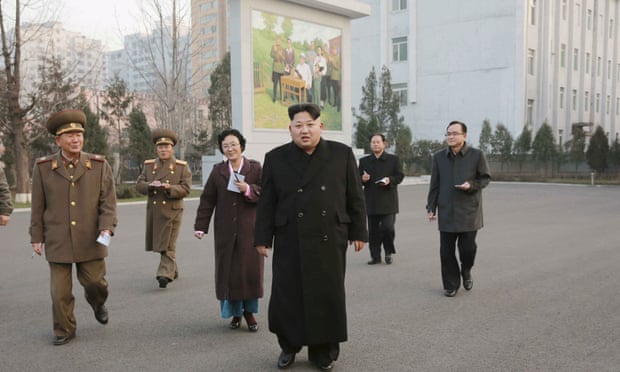By Elena Marchetti.

The Korean Central News Agency (KCNA) published an item on Kim Jong Un’s visit to an historic arms factory, founded by his grandfather, President Kim Il Sung. During the visit Kim supposedly extolled the North Korean arms industry and used language that the media has reported as indicating North Korea has a hydrogen bomb.
Below is reproduced what Kim said, in English translation:
‘The Phyongchon Revolutionary Site is a birthplace of the Songun (i.e., military first) arms,” Kim said. “Every gun, produced thanks to the tireless efforts of the President, has formed a forest of arms defending the Party and the revolution, the country and its people and the historic gun report made by him at the site turned the Democratic Peoples’ Republic of Korea (DPRK) into a powerful nuclear weapons state ready to detonate a self-reliant (i.e., homemade) A-bomb and H-bomb to reliably defend its sovereignty and the dignity of the nation. If we struggle in the same spirit with which the workers produced submachine guns by their own efforts just after the liberation of the country when everything was in need, we can further build up our country into a powerful one no enemy dare to provoke.” He also stressed “the need to steadily put big efforts on the development of the country’s munitions industry associated with devoted efforts of Kim Il Sung and Kim Jong Il,”
The KCNA article used different Korean words for A-bomb and for H-bomb, indicating that the writers were aware that there is a difference. Nevertheless, the run-on sentence is difficult to understand in translation. It attributes the nuclear weapons program to Kim Il Sung who once said North Korea should never have nuclear weapons. The trajectory from making machineguns in the Phyongchon factory to producing nuclear weapons pretty much omits President Kim.
A second point is that the North’s readiness to detonate is separate from its ability to detonate. The North also is ready to launch an ICBM against the US, if it had one that worked. It is not clear that readiness to detonate is the same as possession. The North lies whenever it is in its interest especially when the international community is not paying it much attention.
Still, the comments attributed to Kim Jong Un are the first time that KCNA has published an item mentioning the terms DPRK and H-bomb in the same article, but that does not mean Kim actually spoke the Korean word for H-bomb. Everything published by the official media is heavily edited. Only the people who accompanied Kim on the inspection tour know what he actually said, if anything. The North Korean propagandists, however, had to have received approval from Kim himself or from his personal secretariat to publish any remarks supposedly said by the North Korean leader. Everything he says or does is a national secret. The article is evidence the North’s leadership and propagandists understand the impact on their audiences of the language in the KCNA article.
It could just be that the writers conflated existing capabilities (A-bombs) with planned capabilities (H-bombs). Nevertheless, the article supports an inference that North Korean scientists have done at least some research on thermonuclear weapons. The timing of the KCNA article, relative to the high-level meetings in Kaesong on 11 December, is meant to assure all parties that the North’s willingness to engage in discussions does not signify weakness. Concern about its public image seems to be a North Korean concern whenever it engages in negotiations with South Korea or the US. There is no reason to doubt that North Korea would like to develop thermonuclear weapons as the next step in its nuclear weapons program. If it had them, it would certainly be ready to detonate them in defense of North Korea. No thermonuclear detonation has been detected. No weapons expert, who studies North Korea, judges it has developed an H-bomb.
Chinese reaction. At the daily press conference, the foreign ministry spokesman received a question about the KCNA article.
“Reporter: It has been reported that the leader of the DPRK said that the DPRK has become a powerful country with nuclear weapons and that it is capable of detonating atomic bombs and hydrogen bombs developed with independent research. What is your comment on that?”
“Foreign Ministry spokesman: I have taken note of the relevant report. The Chinese side has always called for adhering to the realization of non-nuclearization on the Korean Peninsula, adhering to the maintenance of peace and stability on the Korean Peninsula, and solving the problem through dialogue and consultations. We hope that all parties concerned will make constructive efforts to maintain the peace and stability on the Korean Peninsula and to restart the Six-Party Talks at an early date.”
The government spokesman’s response is as close to a reprimand of North Korea as the Foreign Ministry is likely to go. The Chinese position has been quite consistent, but the target of non-nuclearization has changed. Fifty years ago, China wanted the US to remove nuclear weapons from the Peninsula. North Korea had none. In the past nine years, since the first North Korean nuclear test, North Korea has become China’s target of non-nuclearization.


